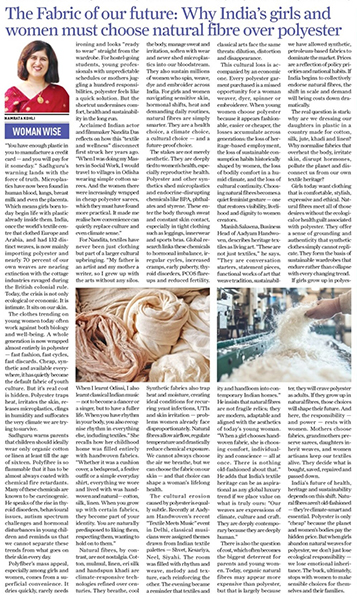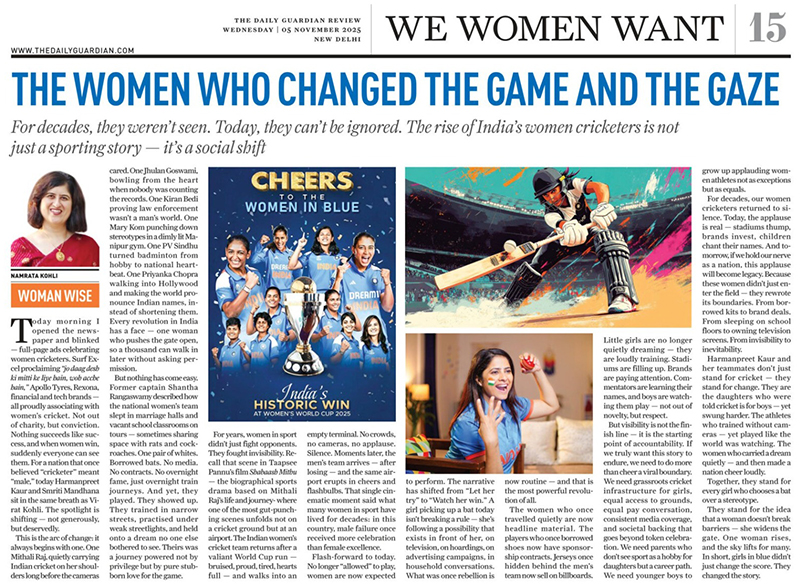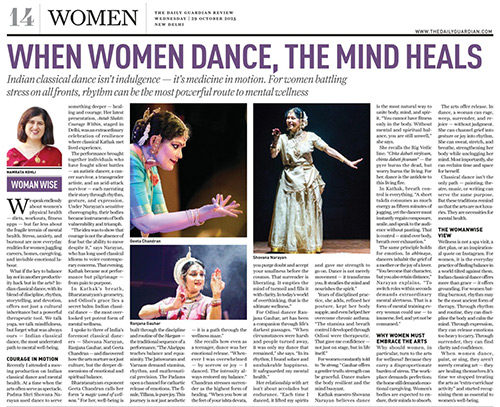“You have enough plastic in you to manufacture a credit card — and you will pay for it someday.” Sadhguru’s warning lands with the force of truth. Micro plastics have now been found in human blood, lungs, breast milk and even the placenta. Which means girls born today begin life with plastic already inside them. India, once the world’s textile centre that clothed Europe and Arabia, and had 132 distinct weaves, is now mainly importing polyester and nearly 70 percent of our own weaves are nearing extinction with the cottage industries ravaged during the British colonial rule. Today, the crisis is not only ecological or economic. It is intimate. It sits on our skin.
The clothes trending on young women today often work against both biology and well-being. A whole generation is now wrapped almost entirely in polyester — fast fashion, fast cycles, fast discards. Cheap, synthetic and available everywhere, it has quietly become the default fabric of youth culture. But it’s real cost is hidden. Polyester traps heat, irritates the skin, releases microplastics, clings in humidity and suffocates the very climate we are trying to survive.
Sadhguru warns parents that children should ideally wear only organic cotton or linen at least till the age of sixteen. Polyfibre is so flammable that it has to be almost always coated with chemical fire retardants. Many of these chemicals are known to be carcinogenic. He speaks of the rise in thyroid disorders, behavioural issues, autism spectrum challenges and hormonal disturbances in young children and reminds us that we cannot separate these trends from what goes on their skin every day.
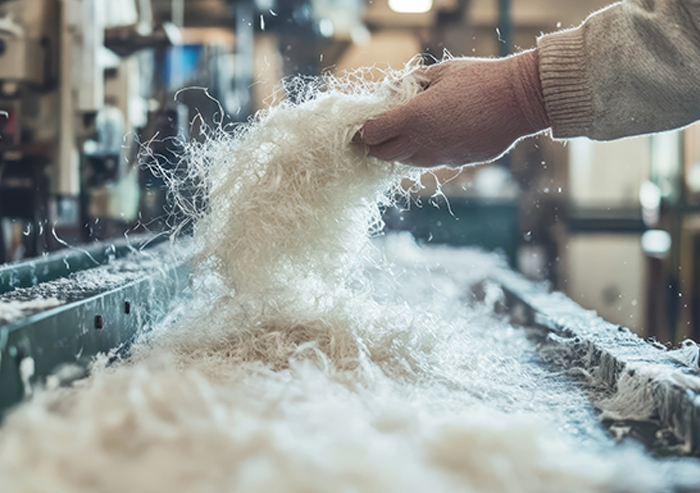
Polyfiber’s mass appeal, especially among girls and women, comes from a superficial convenience. It dries quickly, rarely needs ironing and looks “ready to wear” straight from the wardrobe. For hostel-going students, young professionals with unpredictable schedules or mothers juggling a hundred responsibilities, polyester feels like a quick solution. But the shortcut undermines comfort, health and sustainability in the long run.
Acclaimed Indian actor and filmmaker Nandita Das reflects on how this “textile and wellness” is connect first struck her years ago. “When I was doing my Masters in Social Work, I would travel to villages in Odisha wearing simple cotton sarees. And the women there were increasingly wrapped in cheap polyester sarees, which they must have found more practical. It made me realise how convenience can quietly replace culture and even climate sense.”
For Nandita, textiles have never been just clothing but part of a larger cultural upbringing. “My father is an artist and my mother a writer, so I grew up with the arts without any silos. When I learnt Odissi, I also learnt classical Indian music— not to become a dancer or a singer, but to have a fuller life. When you have rhythm in your body, you also recognise rhythm in everything else, including textiles.” She recalls how her childhood home was filled entirely with handwoven fabrics. “Whether it was a cushion cover, a bedspread, a festive outfit or a simple everyday shirt, everything we wore and lived with was hand- woven and natural— cotton, silk, linen. When you grow up with certain fabrics, they become part of your identity. You are naturally predisposed to liking them, respecting them, wanting to hold on to them.”
Natural fibres, by contrast, are not nostalgia. Cotton, mulmul, linen, eri silk and handspun khadi are climate-responsive technologies refined over centuries. They breathe, cool the body, manage sweat and irritation, soften with wear and never shed microplastics into our bloodstream. They also sustain millions of women who spin, weave, dye and embroider across India. For girls and women navigating sensitive skin, hormonal shifts, heat and demanding daily routines, natural fibres are simply smarter. They are a health choice, a climate choice, a cultural choice — and a future-proof choice.
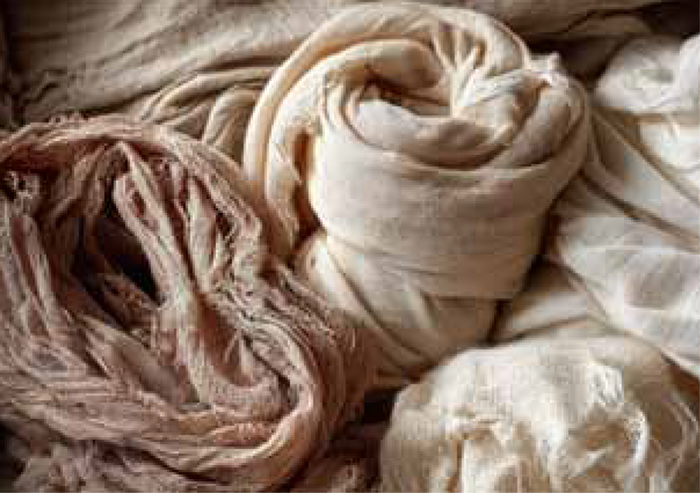
The stakes are not merely aesthetic. They are deeply tied to women’s health, especially reproductive health. Polyester and other synthetics shed microplastics and endocrine-disrupting chemicals like BPA, phthalates and styrene. These enter the body through sweat and constant skin contact, especially in tight clothing such as leggings, innerwear and sports bras. Global research links these chemicals to hormonal imbalance, irregular cycles, increased cramps, early puberty, thyroid disorders, PCOS flareups and reduced fertility. Synthetic fabrics also trap heat and moisture, creating ideal conditions for recurring yeast infections, UTIs and skin irritation — problems women already ace disproportionately. Natural fibres allow airflow, regulate temperature and drastically reduce chemical exposure. We cannot always choose the air we breathe, but we can choose the fabric on our skin — and that choice can shape a woman’s lifelong health.
The cultural erosion caused by polyester is equally subtle. Recently at Aadyam Handwoven’s recent “Textile Meets Music” event in Delhi, classical musicians were assigned themes drawn from Indian textile palettes — Shvet, Kesariya, Neel, Siyahi. The room was filled with rhythm and weave, melody and texture, each reinforcing the other. The evening became a reminder that textiles and classical arts face the same threats: dilution, distortion and disappearance
This cultural loss is accompanied by an economic one. Every polyester garment purchased is a issued opportunity for a woman weaver, dyer, spinner or embroiderer. When young women choose polyester because it appears fashionable, easier or cheaper, the losses accumulate across generations: the loss of heritage-based employment, the loss of sustainable consumption habits historically shaped by women, the loss of bodily comfort in a humid climate, and the loss of cultural continuity. Choosing natural fibres becomes a quiet feminist gesture — one that restores visibility, livelihood and dignity to women creators.
Manish Saksena, Business Head of Aadyam Handwoven, describes heritage textiles as living art. These are not just textiles,” he says. “They are conversation starters, statement pieces, functional works of art that weave tradition, sustainability and handloom into contemporary Indian homes.” He insists that natural fibres are not fragile relics; they are modern, adaptable and aligned with the aesthetics of today’s young woman. “When a girl chooses handwoven fabric, she is choosing comfort, individuality and conscience — all at once. There is nothing old-fashioned about that.” He adds that India’s textile heritage can be as aspirational as any global luxury trend if we place value on what is truly ours: “Our weaves are expressions of climate, culture and craft. They are deeply contemporary because they are deeply human.”
There is also the question of cost, which often becomes the biggest deterrent for parents and young women. Today, organic natural fibres may appear more expensive than polyester, but that is largely because we have allowed synthetic, petroleum-based fabrics to dominate the market. Prices are a reflection of policy priorities and national habits. If India begins to collectively endorse natural fibres, the shift in scale and demand will bring costs down dramatically.
The real question is stark: why are we dressing our daughters in plastic in a country made for cotton, silk, jute, khadi and linen? Why normalise fabrics that overheat the body, irritate skin, disrupt hormones, pollute the planet and disconnect us from our own textile heritage?
Girls today want clothing that is comfortable, stylish, expressive and ethical. Natural fibres meet all of those desires without the ecological or health guilt associated with polyester. They offer a sense of grounding and authenticity that synthetic clothes simply cannot replicate. They form the basis of sustainable wardrobes that endure rather than collapse with every changing trend.
If girls grow up in polyester, they will crave polyester as adults. If they grow up in natural fibres, those choices will shape their future. And here, the responsibility —and power — rests with women. Mothers choose fabrics, grandmothers preserve sarees, daughters inherit weaves, and women artisans keep our textiles alive. They decide what is bought, saved, repaired and passed down.
India’s future of health, heritage and sustainability depends on this shift. Natural fibres aren’t old-fashioned — they’re climate-smart and essential. Polyester is only “cheap” because the planet and women’s bodies pay the hidden price. But when girls abandon natural weaves for polyester, we don’t just lose ecological responsibility —we lose emotional inheritance. The buck, ultimately, stops with women to make sensible choices for themselves and their families


